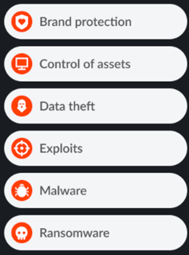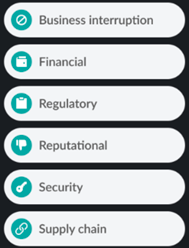What are KYND Recommendations and how are they picked? What do the Risk Factors tags represent?

The top 5 recommendations in KYND START PDF Report are determined by the results found for the organisation. Based upon these results, the risks are ranked in order from most to least harmful and KYND shows the 5 highest priority actions that should be taken. For reference, the top offenders would be i.e. vulnerable software, open ports (or other type of infrastructure access) and email security. An example of a less harmful risk would be an expired website certificate.
KYND Recommendations are then tagged accordingly with the following rules:
Entry risk factors (how the issue arises):

-
Email – any risk that originates through user or employee emails. The top risks caused by email security gaps are spoofing and phishing; others could be malware, ransomware or a directory harvest attack.
-
Lapsed processes - a temporary failure in arrangements for cyber safety. Often these are caused because organisations don’t have standardised processes and rules for setting up and maintaining new and existing domains, certificates, services etc.
-
Phishing - a type of attack often used to steal user data, including login credentials and credit card numbers. It occurs when an attacker, impersonating a trusted entity, tricks a victim into opening an email, instant message or text message.
-
Public/unsecured assets - any valuable data, device or other component of an organisation’s systems that has been left externally visible – or admin/developer access to those components. These often contain sensitive data, critical systems or can be used to access such areas.
-
Vulnerable assets - any valuable data, device or other component of an organisation’s systems that has well-known vulnerabilities which can be easily exploited by attackers. These often contain sensitive data, critical systems or can be used to access such areas.
-
Social engineering - a manipulation technique that exploits human error to gain private information, access, or valuables. In cybercrime, these “human hacking” scams tend to lure unsuspecting users into exposing data, spreading malware infections, or giving access to restricted systems.
How the risk operates:

-
Data theft - is the act of stealing information stored on an organisation's computers, servers, or other devices with the intent to compromise privacy or obtain confidential information.
-
Exploits - a type of cyber attack that finds and takes advantage of existing vulnerabilities in an organisation's software, hardware, systems or networks, typically for malicious purposes such as installing malware.
-
Malware - short for "malicious software, refers to any kind of intrusive computer software designed to infect an organisation's systems or devices and inflict harm on them in multiple ways (e.g., ransomware, spyware, botnets, worms).
-
Ransomware - a type of malicious software that prevents a victim user or organisation from accessing their files by encrypting them. The attacker then demands a ransom to restore access to the data upon payment.
-
Brand protection – attacks which use an organisation’s brand in an illegal or malicious way, violate or infringe its intellectual property, or other attacks that harm a company's name and image.
-
Control of assets – attacks which involve the attacker taking control of valuable company assets such as domains, services or servers.
The impact of the risk:

-
Business Interruption - occurs when an organisation can't perform its normal business activities as a result of a cybersecurity incident. The business interruption caused by a cyber event, particularly a system outage, can cause significant financial loss, operational breakdown and customer dissatisfaction.
-
Financial - in the event of a successful cyber attack, organisations often face substantial financial loss arising from recovery (e.g. repairing affected systems, networks), theft of data, loss of business or the contract.
-
Regulatory - Data protection and privacy regulations require organisations to ensure the security of all Personally Identifiable Information (PII) - whether it belongs to their employees or customers. If this data is accidentally or deliberately compromised, and the organisation has failed to deploy appropriate security measures, it may be subject to fines and regulatory sanctions.
-
Reputational - cyber incidents can potentially damage an organisation's reputation and erode the hard-earned trust of their customers. This, in turn, may lead to loss of clients and subsequent reduction in revenue.
-
Security – some cyber attacks can compromise the security of other parts of your infrastructure. This includes attacks that involve installing additional software that may not itself be dangerous (e.g. bitcoin mining software). Attacks like this may cause longer-term issues on top of the immediate impact.
-
Supply Chain - threats that affect the distributed and interconnected nature of partners in a supply chain – such as email impersonation, malware, data theft and bank transfer fraud. These attacks might not target your business, but your business partners instead.
Click here to browse other help articles or contact us using a chat icon on the right!
